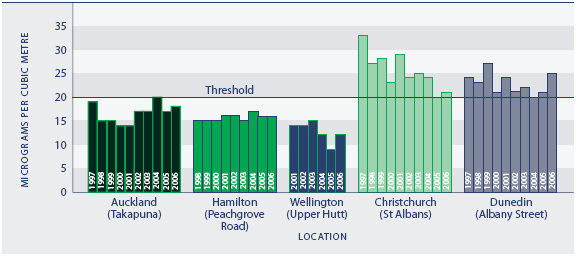Air quality
Definition
The average annual PM10 levels in selected sites above the ambient PM10 guidelines.
PM10 is particulate matter that is less than 10 microns in diameter. The New Zealand ambient air quality guideline for PM10 is 20 micrograms per cubic metre (20µg/m3), averaged annually.
Relevance
Good air quality is an important component in maintaining our quality of life, the appeal of New Zealand as a tourist destination, and the health of our people, plants and animals. PM10 is the primary contaminant of concern in New Zealand and it is known to adversely affect the health of many people. Health effects associated with this contaminant include increased premature mortality, the aggravation of existing respiratory and cardiovascular diseases, hospital admissions and emergency department visits, school absences, lost work days and restricted activity days.
Current level and trends
Figure EN1.1 shows the average annual PM10 levels in the air at selected monitoring sites in the five major cities. At the Christchurch and Dunedin sites, average annual PM10 levels were above the ambient guideline for all years we have data except in 2005 in Christchurch and 2004 in Dunedin when the guideline was met. The Auckland site was at or below the guideline in all years for which we have data. Recorded PM10 levels at the Hamilton and Wellington sites were consistently below the New Zealand annual guideline.
Poor air quality in New Zealand is typically associated with urban areas and is a product of domestic home heating (nationally) and vehicle emissions (Auckland). Lesser sources of PM10 are industrial and agricultural emissions and the natural sources of small particles, dust pollens and sea spray.
The annual data presented here should not be confused with daily average PM10 concentrations. In September 2005, new air quality standards were introduced based on daily average PM10 concentrations. To date regional and unitary authorities have declared 69 "airsheds" where air quality may, or is known to, exceed the standards for PM10 or may require management in the future. When sufficient data is available, we will report against these standards.
Figure EN1.1 PM10 concentration in selected sites, 1997–2006

Source: Collated from regional council publications by the Ministry for the Environment up to 2005
Notes: (1) 2006 data is provisional (2) Data unavailable for Wellington before 2001 and Hamilton before 1998
International comparison
Ambient air quality is entirely location-specific and it is not possible to compare countries. For example, it is possible to compare annual PM10 in Auckland with annual PM10 in Los Angeles, but a comparison between New Zealand and the United States or other OECD countries cannot be calculated. New Zealand's urban air quality is, however, broadly comparable with or better than the air quality in a number of urban areas in OECD countries.
|

